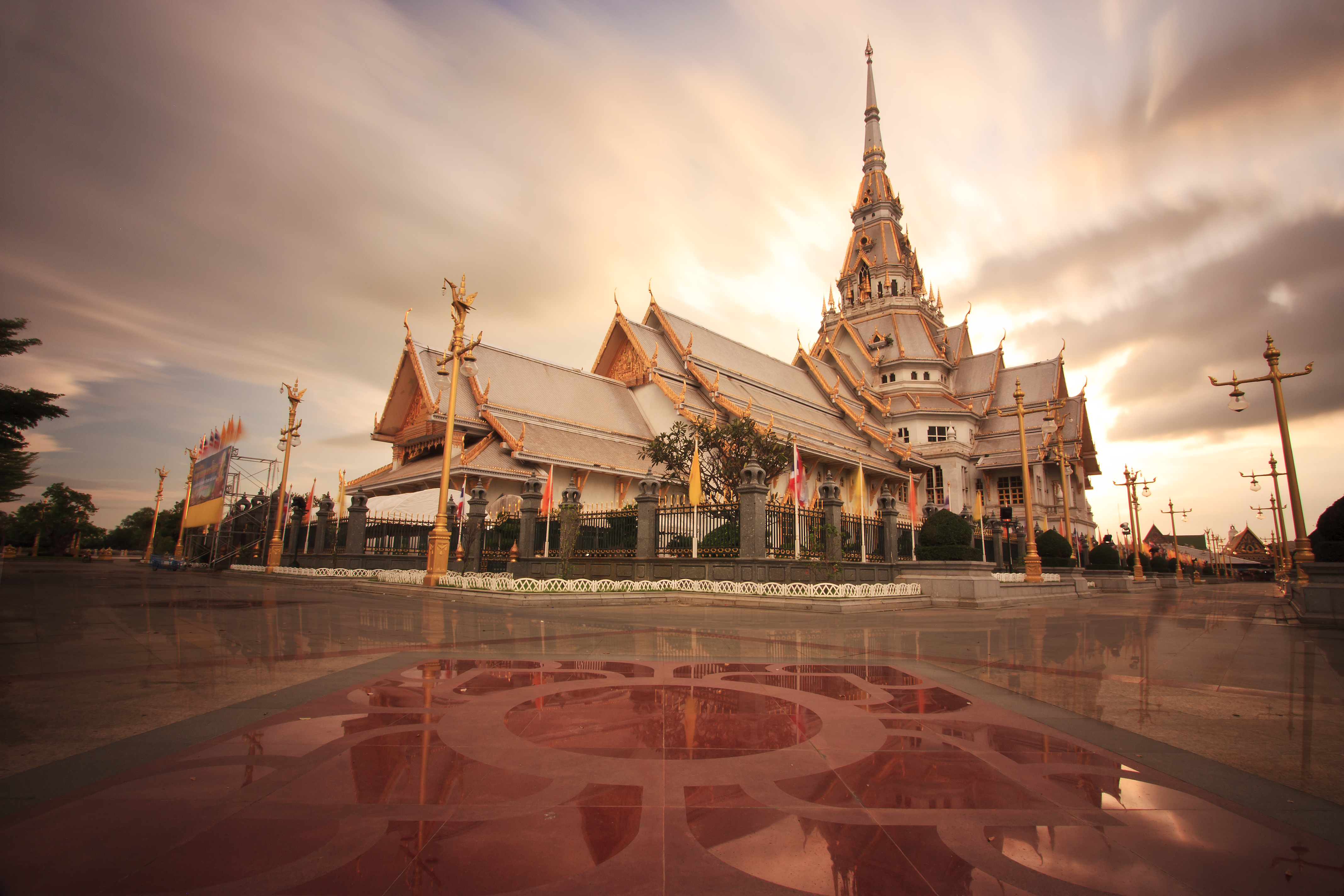|
Wat Sothonwararam
Wat Sothonwararam is a temple in Chachoengsao Province, Thailand. Located in the Municipality of Mueang Chachoengsao alongside the Bang Pakong River, it was initially named ‘Wat Hong,’ and was built in the late Ayutthaya Ayutthaya, Ayudhya, or Ayuthia may refer to: * Ayutthaya Kingdom, a Thai kingdom that existed from 1350 to 1767 ** Ayutthaya Historical Park, the ruins of the old capital city of the Ayutthaya Kingdom * Phra Nakhon Si Ayutthaya province (locally ... period. The temple has the ‘Luangpho Phuttha Sothon,’ the revered Buddha image of Chachoengsao province, which is 1.48 metres high, with a lap width of 1.65 metres. 300px, Luangpho Phuttha Sothon ReferencesThailand Info Portal Buddhist temples in Chachoengsao Province {{Thailand-stub ... [...More Info...] [...Related Items...] OR: [Wikipedia] [Google] [Baidu] |
Wat Sothorn 11
A wat ( km, វត្ត, ; lo, ວັດ, ; th, วัด, ; khb, 「ᩅᨯ᩠ᨰ」(waD+Dha); nod, 「ᩅ᩠ᨯ᩶」 (w+Da2)) is a type of Buddhist temple and Hindu temple in Cambodia, Laos, East Shan State, Yunnan, the Southern Province of Sri Lanka and Thailand. The word ''wat'' is a Thai word that was borrowed from Sanskrit ''vāṭa'' (Devanāgarī: वाट), meaning 'enclosure'. The term has varying meanings in each region, sometimes referring to a specific type of government-recognised or large temple, other times referring to any Buddhist or Hindu temple. Overview Strictly speaking, a ''wat'' is a Buddhist sacred precinct with vihara (quarters for bhikkhus), a temple, an edifice housing a large image of Buddha and a facility for lessons. A site without a minimum of three resident ''bhikkhu''s cannot correctly be described as a wat although the term is frequently used more loosely, even for ruins of ancient temples. As a transitive or intransitive verb, ''w ... [...More Info...] [...Related Items...] OR: [Wikipedia] [Google] [Baidu] |
Chachoengsao Province
Chachoengsao ( th, ฉะเชิงเทรา, ) is one of Thailand's seventy-six provinces (''changwat''), located in eastern Thailand. History ''Chachoengsao'' or ''Paet Riu'' ('eight stripes') is a province in eastern Thailand. It has a history dating back to the reign of King Borommatrailokkanat in the mid- Ayutthaya period. People originally settled by the Bang Pakong River and along canals. Chachoengsao, Paet Rio, has a history dating back to the reign of King Borommatrailokkanat in the Ayutthaya period. Most people have settled by the Bang Pakong River and along canals. "Luangpho Phuttha Sothon" is a centre of faith of the people of Paet Rio. In the past, Chachoengsao was a fourth class city under the ministry of defence. During the reign of King Rama I, it was attached to the ministry of the interior. During the reign of King Rama V, who changed the administration system, Chachoengsao became a city in the Prachin Buri Circle. In 1916, its status was changed from a ci ... [...More Info...] [...Related Items...] OR: [Wikipedia] [Google] [Baidu] |
Thailand
Thailand ( ), historically known as Siam () and officially the Kingdom of Thailand, is a country in Southeast Asia, located at the centre of the Indochinese Peninsula, spanning , with a population of almost 70 million. The country is bordered to the north by Myanmar and Laos, to the east by Laos and Cambodia, to the south by the Gulf of Thailand and Malaysia, and to the west by the Andaman Sea and the extremity of Myanmar. Thailand also shares maritime borders with Vietnam to the southeast, and Indonesia and India to the southwest. Bangkok is the nation's capital and largest city. Tai peoples migrated from southwestern China to mainland Southeast Asia from the 11th century. Indianised kingdoms such as the Mon, Khmer Empire and Malay states ruled the region, competing with Thai states such as the Kingdoms of Ngoenyang, Sukhothai, Lan Na and Ayutthaya, which also rivalled each other. European contact began in 1511 with a Portuguese diplomatic mission to Ayutthaya, w ... [...More Info...] [...Related Items...] OR: [Wikipedia] [Google] [Baidu] |
Bang Pakong River
The Bang Pakong ( th, แม่น้ำบางปะกง, , ) is a river in east Thailand. The river originates at the confluence of the Phra Prong River and the Hanuman River near Kabin Buri, Prachinburi Province. It empties after 231 kilometres into the Gulf of Thailand at the northeastern tip of the Bay of Bangkok. The watershed of the Bang Pakong is about . The river powers a power station near its mouth, near Highway 7. To protect the Irrawaddy dolphins, fishermen on the Bang Pakong River have been persuaded by authorities to stop shrimping and 30 to 40 fishing boats have been modified so they can offer dolphin sightseeing tours. Dvaravati settlements include Muang Phra Rot, Dong Si Maha Phot, Dong Lakhon, and Ban Khu Muang. Dvaravati coins have been found at U-Tapao.Higham, C., 2014, ''Early Mainland Southeast Asia''. Bangkok: River Books Co., Ltd., Toponymy Its name "Bang Pakong" is believed to be distorted from the word "Bang Mangkong" (บางมังก� ... [...More Info...] [...Related Items...] OR: [Wikipedia] [Google] [Baidu] |
Ayutthaya Kingdom
The Ayutthaya Kingdom (; th, อยุธยา, , IAST: or , ) was a Siamese kingdom that existed in Southeast Asia from 1351 to 1767, centered around the city of Ayutthaya, in Siam, or present-day Thailand. The Ayutthaya Kingdom is considered to be the precursor of modern Thailand and its developments are an important part of the History of Thailand. The Ayutthaya Kingdom emerged from the mandala of city-states on the Lower Chao Phraya Valley in the late fourteenth century during the decline of the Khmer Empire. After a century of territorial expansions, Ayutthaya became centralized and rose as a major power in Southeast Asia. Ayutthaya faced invasions from the Toungoo dynasty of Burma, starting a centuries' old rivalry between the two regional powers, resulting in the First Fall of Ayutthaya in 1569. However, Naresuan ( 1590–1605) freed Ayutthaya from brief Burmese rule and expanded Ayutthaya militarily. By 1600, the kingdom's vassals included some city-states in the M ... [...More Info...] [...Related Items...] OR: [Wikipedia] [Google] [Baidu] |

.jpg)

_of_Wat_Phra_Si_Sanphet.jpg)